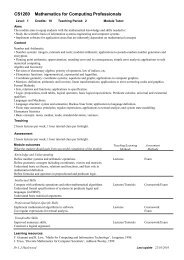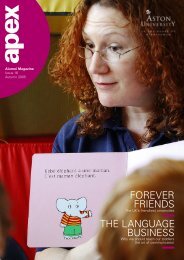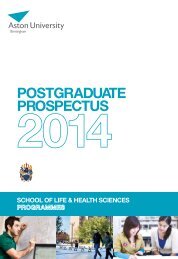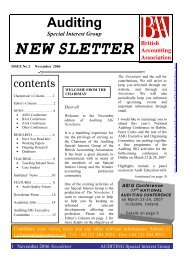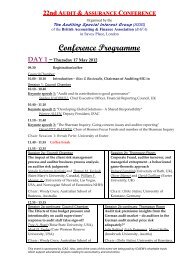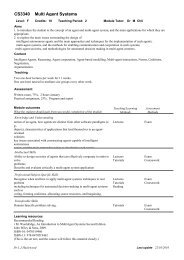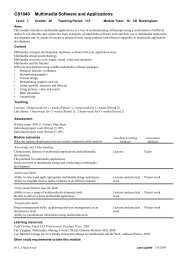Postgraduate ProsPectus - Aston University
Postgraduate ProsPectus - Aston University
Postgraduate ProsPectus - Aston University
You also want an ePaper? Increase the reach of your titles
YUMPU automatically turns print PDFs into web optimized ePapers that Google loves.
School of Engineering & Applied Science<br />
Biomedical Engineering Research Group<br />
School of Engineering & Applied Science<br />
Computer Science Research Group<br />
Group overview<br />
The Group has five academic staff with international<br />
track records of working at the interfaces between<br />
engineering and medicine, biology, manufacturing and<br />
design. The group produces innovative state-of-the-art<br />
devices for use in surgery, medicine and rehabilitation.<br />
Research interests<br />
Medical devices including artificial heart implants,<br />
neurosensory devices (cochlear)<br />
Robotics including micro-robotic surgical tools<br />
Smart sensing systems for discriminating tissues,<br />
cells, proteins on the micro and nano scale<br />
Biomechanics including cell mechanics,<br />
computational and experimental bloodflow<br />
dynamics.<br />
We would be interested in supervising projects in the<br />
areas of novel medical devices, sensing and diagnosis<br />
systems, modelling in biomedical engineering.<br />
Current projects<br />
Development of a smart catheter for endovascular<br />
intervention<br />
Microsystems for medical diagnosis<br />
Occular alignment for ophthalmic instruments<br />
Development of a combination optical coherence<br />
tomography and high resolution imaging system<br />
Chronic intermittent mechanical cardiac support<br />
Modelling of carotid atherosclerotic plaque stability<br />
Modelling of anterior eye tissues.<br />
Specialist equipment<br />
State-of-the-art facilities such as confocal<br />
microscopes, microlaser tracking systems, atomic<br />
force microscope, scanning micro laser vibrometer,<br />
EMG monitoring equipment, robotic manipulators and<br />
rapid prototyping facilities.<br />
Funding sources<br />
Our research is funded by a range of research councils,<br />
government bodies, charity foundations and industrial<br />
sponsors.<br />
Collaboration<br />
We work closely with hospitals and international<br />
institutions, such as the QE hospital in Birmingham,<br />
St George’s hospital in London, <strong>University</strong> of Illinois<br />
and the World Academy of Biomedical Technology of<br />
UNESCO.<br />
Group overview<br />
The Computer Science Research Group brings<br />
together expertise from a wide range of Computer<br />
Science areas. Group members pursue funded<br />
research in five main themes: computational<br />
intelligence, software engineering, pattern analysis,<br />
visual information processing and cognitive science.<br />
The theory and tools developed by the group are used<br />
in application domains ranging from health informatics<br />
to geoinformatics. The group has close links with the<br />
Non-linearity and Complexity Research Group.<br />
Research interests<br />
We are interested in supervising projects in:<br />
Health informatics, specialising in clinical decision<br />
support and ontologies<br />
Computational intelligence: agent-based systems,<br />
evolutionary computation, semantic web, and<br />
spatial systems<br />
Software engineering: reliable software, adaptive<br />
computer systems<br />
Visual Information Processing: visual 3D inference,<br />
video analysis<br />
Cognitive science: computational models of<br />
decision processes, human-computer interaction<br />
(HCI), including mobile HCI.<br />
Current projects<br />
GRiST tool for mental health decision support<br />
GeoViQua improving data from earth observation<br />
systems with applications in ecology and<br />
meteorology<br />
ADVANCE: improved decision support for logistics.<br />
Specialist equipment<br />
<strong>Aston</strong> Interactive Media Lab: for the design and<br />
evaluation of novel interaction technologies and<br />
computer vision<br />
High-performance computer clusters run by the<br />
School.<br />
Funding sources<br />
UK research councils and National Health Service,<br />
industry (Knowledge Transfer Partnerships and CASE<br />
studentships), charities, and the EU.<br />
Collaboration<br />
Collaborations are organised around the development<br />
of real-world applications, and have led to innovative<br />
systems that are used in industry and the health<br />
service.<br />
Application and contact<br />
Research Group Convenor<br />
Professor Ian Nabney<br />
T: +44 (0)121 204 3645<br />
F +44 (0)121 204 3676<br />
E: i.t.nabney@aston.ac.uk<br />
W: www.aston.ac.uk/eas/research/groups/csrg<br />
Application and contact<br />
Research Group Convenor<br />
Dr Xianghong Ma<br />
T: +44 (0)121 204 3592<br />
E: x.ma@aston.ac.uk<br />
W: www.aston.ac.uk/eas/research/groups/biomedical<br />
54 To find out more: Telephone: +44 (0)121 204 3400 | Email: engineering@aston.ac.uk | www.aston.ac.uk/eas<br />
www.aston.ac.uk<br />
55



